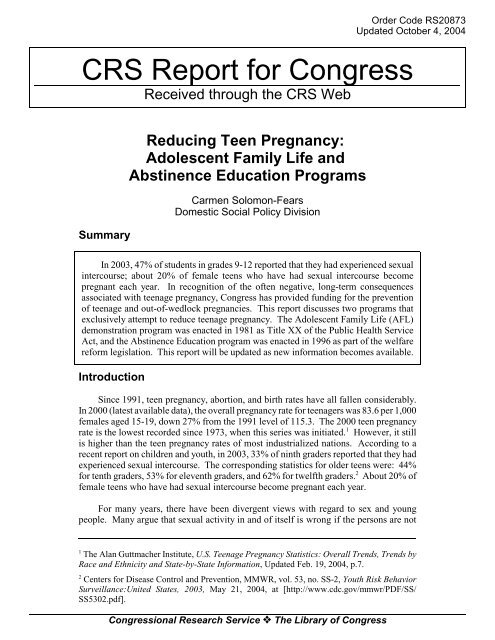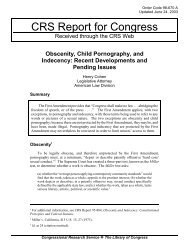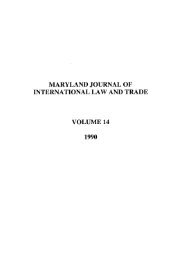Reducing Teen Pregnancy: Adolescent Family Life and Abstinence ...
Reducing Teen Pregnancy: Adolescent Family Life and Abstinence ...
Reducing Teen Pregnancy: Adolescent Family Life and Abstinence ...
Create successful ePaper yourself
Turn your PDF publications into a flip-book with our unique Google optimized e-Paper software.
CRS Report for Congress<br />
Received through the CRS Web<br />
Summary<br />
<strong>Reducing</strong> <strong>Teen</strong> <strong>Pregnancy</strong>:<br />
<strong>Adolescent</strong> <strong>Family</strong> <strong>Life</strong> <strong>and</strong><br />
<strong>Abstinence</strong> Education Programs<br />
Carmen Solomon-Fears<br />
Domestic Social Policy Division<br />
1 The Alan Guttmacher Institute, U.S. <strong>Teen</strong>age <strong>Pregnancy</strong> Statistics: Overall Trends, Trends by<br />
Race <strong>and</strong> Ethnicity <strong>and</strong> State-by-State Information, Updated Feb. 19, 2004, p.7.<br />
2 Centers for Disease Control <strong>and</strong> Prevention, MMWR, vol. 53, no. SS-2, Youth Risk Behavior<br />
Surveillance:United States, 2003, May 21, 2004, at [http://www.cdc.gov/mmwr/PDF/SS/<br />
SS5302.pdf].<br />
Congressional Research Service ˜ The Library of Congress<br />
Order Code RS20873<br />
Updated October 4, 2004<br />
In 2003, 47% of students in grades 9-12 reported that they had experienced sexual<br />
intercourse; about 20% of female teens who have had sexual intercourse become<br />
pregnant each year. In recognition of the often negative, long-term consequences<br />
associated with teenage pregnancy, Congress has provided funding for the prevention<br />
of teenage <strong>and</strong> out-of-wedlock pregnancies. This report discusses two programs that<br />
exclusively attempt to reduce teenage pregnancy. The <strong>Adolescent</strong> <strong>Family</strong> <strong>Life</strong> (AFL)<br />
demonstration program was enacted in 1981 as Title XX of the Public Health Service<br />
Act, <strong>and</strong> the <strong>Abstinence</strong> Education program was enacted in 1996 as part of the welfare<br />
reform legislation. This report will be updated as new information becomes available.<br />
Introduction<br />
Since 1991, teen pregnancy, abortion, <strong>and</strong> birth rates have all fallen considerably.<br />
In 2000 (latest available data), the overall pregnancy rate for teenagers was 83.6 per 1,000<br />
females aged 15-19, down 27% from the 1991 level of 115.3. The 2000 teen pregnancy<br />
rate is the lowest recorded since 1973, when this series was initiated. 1 However, it still<br />
is higher than the teen pregnancy rates of most industrialized nations. According to a<br />
recent report on children <strong>and</strong> youth, in 2003, 33% of ninth graders reported that they had<br />
experienced sexual intercourse. The corresponding statistics for older teens were: 44%<br />
for tenth graders, 53% for eleventh graders, <strong>and</strong> 62% for twelfth graders. 2 About 20% of<br />
female teens who have had sexual intercourse become pregnant each year.<br />
For many years, there have been divergent views with regard to sex <strong>and</strong> young<br />
people. Many argue that sexual activity in <strong>and</strong> of itself is wrong if the persons are not
CRS-2<br />
married. Others agree that it is better for teenagers to abstain from sex but are primarily<br />
concerned about the negative consequences of sexual activity, namely unintended<br />
pregnancy <strong>and</strong> sexually transmitted diseases (STDs). These two viewpoints are reflected<br />
in two pregnancy prevention approaches. The <strong>Adolescent</strong> <strong>Family</strong> <strong>Life</strong> (AFL) program<br />
encompasses both views <strong>and</strong> provides funding for both prevention programs <strong>and</strong><br />
programs that provide medical <strong>and</strong> social services to pregnant or parenting teens. The<br />
<strong>Abstinence</strong> Education program centers on the abstinence-only message <strong>and</strong> only funds<br />
programs that adhere solely to bolstering that message. (For information on Title X,<br />
which serves a much broader clientele than teens <strong>and</strong> pre-teens, see CRS Report 97-1048,<br />
The Title X <strong>Family</strong> Planning Program.)<br />
The <strong>Adolescent</strong> <strong>Family</strong> <strong>Life</strong> Program<br />
The AFL demonstration program was enacted in 1981 as Title XX of the Public<br />
Health Service Act (P.L. 97-35). It is administered by the Office of <strong>Adolescent</strong> <strong>Pregnancy</strong><br />
Programs, Department of Health <strong>and</strong> Human Services (HHS). From 1981 until 1996, the<br />
AFL program was the only federal program that focused directly on the issues of<br />
adolescent sexuality, pregnancy, <strong>and</strong> parenting. 3<br />
Program Purpose. The AFL program was designed to promote — family<br />
involvement in the delivery of services, adolescent premarital sexual abstinence, adoption<br />
as an alternative to early parenting, parenting <strong>and</strong> child development education, <strong>and</strong><br />
comprehensive health, education, <strong>and</strong> social services geared to help the mother have a<br />
healthy baby <strong>and</strong> improve subsequent life prospects for both mother <strong>and</strong> child.<br />
Allowable Projects. The AFL program authorizes grants for three types of<br />
demonstrations: (1) projects provide “care” services only (i.e., health, education, <strong>and</strong><br />
social services to pregnant adolescents, adolescent parents, their infant, families, <strong>and</strong> male<br />
partners); (2) projects which provide “prevention” services only (i.e., services to promote<br />
abstinence from premarital sexual relations for pre-teens, teens, <strong>and</strong> their families); <strong>and</strong><br />
(3) projects which provide a combination of care <strong>and</strong> prevention services. Any public or<br />
private nonprofit organization or agency is eligible to apply for a demonstration grant.<br />
AFL projects can be funded for up to five years. Currently, the AFL program is<br />
supporting 107 demonstration projects across the country. (Source:<br />
[http://opa.osophs.dhhs.gov/titlexx/oapp.html])<br />
AFL care projects are required to provide comprehensive health, education, <strong>and</strong><br />
social services (including life <strong>and</strong> career planning, job training, safe housing, decisionmaking<br />
<strong>and</strong> social skills), either directly or through partnerships with other community<br />
agencies, <strong>and</strong> to evaluate new approaches for implementing these services. AFL care<br />
projects are based within a variety of settings such as universities, hospitals, schools,<br />
public health departments, or community agencies. Many provide home visiting services<br />
3 The predecessor of the AFL program was the <strong>Adolescent</strong> <strong>Pregnancy</strong> program, which was<br />
enacted in 1978 (P.L. 95-626). The <strong>Adolescent</strong> <strong>Pregnancy</strong> program was designed to alleviate the<br />
negative consequences of pregnancy for the adolescent parent <strong>and</strong> her child (i.e., the care<br />
component of the AFL program). The <strong>Adolescent</strong> <strong>Pregnancy</strong> program was consolidated into the<br />
Maternal <strong>and</strong> Child Health Block Grant when the AFL program was enacted.
CRS-3<br />
<strong>and</strong> all have partnerships with diverse community agencies. Currently, 45 care projects<br />
are being funded; eight of the projects started in FY2002.<br />
Since 1997, all AFL prevention projects that have been funded have been abstinenceonly<br />
projects that were required to conform to the definition of abstinence education as<br />
defined in P.L. 104-193. Most of these projects try to reach students between the ages of<br />
9 to 14 in public schools, community settings or family households; all involve significant<br />
interaction with parents to strengthen the abstinence message. Currently, 62 abstinenceonly<br />
projects are being funded; 38 of the projects started in FY2002, 6 started in FY2003.<br />
Evaluations <strong>and</strong> Research. Each demonstration project is required to include<br />
an internal evaluation component designed to test hypotheses specific to that project’s<br />
service delivery model. The grantee contracts with an independent evaluator, usually one<br />
affiliated with a college or university in the grantee’s state. The AFL program also<br />
authorizes funding of research grants dealing with various aspects of adolescent sexuality,<br />
pregnancy, <strong>and</strong> parenting. Research projects have examined factors that influence teenage<br />
sexual, contraceptive <strong>and</strong> fertility behaviors, the nature <strong>and</strong> effectiveness of care services<br />
for pregnant <strong>and</strong> parenting teens <strong>and</strong> why adoption is a little-used alternative among<br />
pregnant teenagers. Since 1982, the AFL program has funded 68 research projects.<br />
<strong>Adolescent</strong> <strong>Family</strong> <strong>Life</strong> Program (appropriations in millions of dollars)<br />
Fiscal year Appropriation Fiscal year Appropriation Fiscal year Appropriation<br />
1982 $11.080 1990 $9.421 1998 $16.709<br />
1983 13.518 1991 7.789 1999 17.700<br />
1984 14.918 1992 7.789 2000 19.327<br />
1985 14.716 1993 7.598 2001 24.377<br />
1986 14.689 1994 6.250 2002 28.900<br />
1987 14.000 1995 6.698 2003 30.922<br />
1988 9.626 1996 7.698 2004 30.720<br />
1989 9.529 1997 14.209<br />
<strong>Abstinence</strong> Education<br />
1996 Welfare Reform. P.L. 104-193, the 1996 welfare reform law, provides $250<br />
million in federal funds specifically for the abstinence education program ($50 million per<br />
year for five years, FY1998-FY2002). Funds must be requested by states when they<br />
solicit Title V Maternal <strong>and</strong> Child Health (MCH) block grant funds <strong>and</strong> must be used<br />
exclusively for teaching abstinence. To receive federal funds, a state must match every<br />
$4 in federal funds with $3 in state funds. 4 This means that funding for abstinence<br />
education must total at least $87.5 million annually. Although the Title V abstinence-only<br />
education block grant has not yet been reauthorized, several extension bills have<br />
continued funding for the grant. The latest extension (H.R. 5149) continues funding for<br />
4 States use a variety of methods to meet the federal matching requirement, such as state funds,<br />
private or foundation funds, matching funds from community-based grantees, <strong>and</strong> in-kind<br />
services (e.g., volunteer staffing, public service announcements, etc.).
CRS-4<br />
the Title V abstinence-only block grant through March 31, 2005. 5 P.L. 105-33, enacted<br />
in 1997, included funding for a scientific evaluation of the abstinence education<br />
programs; P.L. 106-554 required an interim report. Mathematica Policy Research won<br />
the contract for the evaluation. (See The Evaluation of <strong>Abstinence</strong> Education Programs<br />
Funded Under Title V Section 510:Interim Report [http://aspe.hhs.gov/hsp/abstinence02/<br />
index.htm].) The final report is due in 2005.<br />
To ensure that the abstinence-only message is not diluted, the law (P.L. 104-193,<br />
Section 510 of the Social Security Act) stipulated that the term “abstinence education”<br />
means an educational or motivational program that — (1) has as its exclusive purpose,<br />
teaching the social, psychological, <strong>and</strong> health gains of abstaining from sexual activity; (2)<br />
teaches abstinence from sexual activity outside of marriage as the expected st<strong>and</strong>ard for<br />
all school-age children; (3) teaches that abstinence is the only certain way to avoid<br />
out-of-wedlock pregnancy, STDs, <strong>and</strong> associated health problems; (4) teaches that a<br />
mutually faithful monogamous relationship within marriage is the expected st<strong>and</strong>ard of<br />
human sexual activity; (5) teaches that sexual activity outside of marriage is likely to have<br />
harmful psychological <strong>and</strong> physical effects; (6) teaches that bearing children<br />
out-of-wedlock is likely to have harmful consequences for the child, the child’s parents,<br />
<strong>and</strong> society; (7) teaches young people how to reject sexual advances <strong>and</strong> how alcohol <strong>and</strong><br />
drug use increases vulnerability to sexual advances; <strong>and</strong> (8) teaches the importance of<br />
attaining self-sufficiency before engaging in sex.<br />
What Is <strong>Abstinence</strong>?<br />
It is becoming clear that parents, teachers, <strong>and</strong> teenagers are not in agreement on what constitutes<br />
abstinence. <strong>Teen</strong>s are more likely than adults to believe that behaviors that cannot result in pregnancy<br />
constitute abstinence. Because pregnancy prevention together with avoidance of STDs are dual goals<br />
of the abstinence education program, some observers contend that it is time for programs to explicitly<br />
define what constitutes sexual activity. Others contend that specifying behaviors other than sexual<br />
intercourse violates a child’s innocence <strong>and</strong> may provide ideas for experimentation. Source: Lisa Remez,<br />
“Oral Sex among <strong>Adolescent</strong>s: Is It Sex or Is It <strong>Abstinence</strong>?” <strong>Family</strong> Planning Perspectives (Alan<br />
Guttmacher Institute), 32(6), Nov-Dec. 2000, pp. 298-304.<br />
In FY2003, every state except California (<strong>and</strong> several territories) sponsored an<br />
abstinence education program. These programs launch media campaigns to influence<br />
attitudes <strong>and</strong> behavior, develop abstinence education curricula, revamp sexual education<br />
classes, <strong>and</strong> implement other activities focused on abstinence education. State funding<br />
is based on the proportion of low-income children in the state as compared to the national<br />
total. In FY2003, federal abstinence education funding ranged from $69,855 in Vermont<br />
to $4,922,091 in Texas.<br />
Appropriations for 2001, 2002, 2003, <strong>and</strong> 2004. P.L. 106-246 appropriated<br />
an additional $20 million for FY2001 to HHS under the Special Projects of Regional <strong>and</strong><br />
National Significance (SPRANS) program (funded by the MCH Block grant) for<br />
abstinence education to bolster the abstinence-only message for adolescents aged 12<br />
through 18. P.L. 106-554 also reinforced the abstinence education program by providing<br />
5 H.R. 4, the welfare reform reauthorization bill, which was passed by the House on Feb. 13, 2003<br />
<strong>and</strong> approved, with amendments, by the Senate Finance Committee on Sept. 10, 2003, would<br />
extend funding for the $50 million abstinence-only block grant through FY2008. Although H.R.<br />
4 was debated on the Senate floor during the period Mar. 29-Apr. 1, 2004, consideration of the<br />
bill was not completed.
CRS-5<br />
an additional $30 million for FY2002 for continued funding for abstinence-only education<br />
under the SPRANS program. P.L. 107-116 increased the SPRANS abstinence program<br />
funding from $30 million to $40 million for FY2002. P.L. 108-7 increased funding for<br />
the SPRANS abstinence program to $55 million for FY2003. P.L. 108-199 increased<br />
funding for the SPRANS abstinence education program to $70.0 million for FY2004.<br />
Issues<br />
Comparable Funding for <strong>Abstinence</strong> Education. President Bush has<br />
indicated his support for abstinence education. As governor of Texas, he stated: “For<br />
children to realize their dreams, they must learn the value of abstinence. We must send<br />
them the message that of the many decisions they will make in their lives, choosing to<br />
avoid early sex is one of the most important. We must stress that abstinence isn’t just<br />
about saying no to sex; it’s about saying yes to a happier, healthier future.” 6 The proposal<br />
he supported during his presidential campaign would provide at least as much funding for<br />
abstinence education as is provided for teen contraception services under the Medicaid,<br />
family planning (Title X), <strong>and</strong> AFL programs, namely about $135 million annually. 7<br />
Perhaps as many as 27 other federal programs include a teen contraception component,<br />
but expenditures solely for this component could not be isolated. 8 For FY2004, the<br />
funding for abstinence education totals $135 million: $50 million for the abstinence-only<br />
education block grant; $10 million for the AFL prevention projects, $70 million for the<br />
SPRANS abstinence-only education program, <strong>and</strong> $4.5 million for its evaluation. 9<br />
<strong>Abstinence</strong>-Only Versus Comprehensive Sexuality Education. According<br />
to a 1997 Alan Guttmacher Institute survey, among the 69% of public school districts that<br />
have a district-wide policy to teach sex education, 14% have a comprehensive policy that<br />
treats abstinence as one option for adolescents in a broader sexuality education program;<br />
51% teach abstinence as the preferred option for teenagers, but also permit discussion<br />
about contraception as an effective means of protecting against unintended pregnancy <strong>and</strong><br />
6 Campaign literature from georgebush.com, accessed by author on Nov. 22, 2000.<br />
7 Some family planning experts caution that the spending data may be misleading because it<br />
includes much more than contraception services. They contend that family planning programs<br />
include a vast array of medical services beyond the prescription of a contraceptive method,<br />
including pap smears, breast exams, screening for STDs, <strong>and</strong> one-on-one counseling of teens.<br />
8 The MCH <strong>and</strong> Title XX social services block grants are among the HHS programs that provide<br />
contraceptive services to teens (GAO/HEHS-99-4, <strong>Teen</strong> <strong>Pregnancy</strong>: State <strong>and</strong> Federal Efforts<br />
to Implement Prevention Programs <strong>and</strong> Measure Their Effectiveness, Nov. 1998). In addition,<br />
one of the four purposes of the Temporary Assistance for Needy Families (TANF) block grant<br />
is to prevent out-of-wedlock pregnancies. Thus, TANF funds can also be used for a variety of<br />
programs to achieve this goal/purpose.<br />
9 Funding for abstinence education amounted to $79 million in FY2001, $100 million in FY2002,<br />
<strong>and</strong> $115 million in FY2003. President Bush’s proposed FY2005 budget would double funding<br />
for abstinence-only education to $273 million. It includes a continuation of the $50 million block<br />
grant, $26.240 million for the AFL program, $186.426 million for the SPRANS abstinence-only<br />
education program (including $4.5 million for an evaluation), <strong>and</strong> $10 million for a national<br />
abstinence education campaign. On Sept. 9, 2004, the House passed the Labor, HHS, Education,<br />
<strong>and</strong> Related Agencies Appropriations for FY2005 (H.R. 5006), which included $191 million for<br />
abstinence-only education.
CRS-6<br />
disease (an abstinence-plus policy); <strong>and</strong> 35% teach abstinence as the only option outside<br />
of marriage, with discussion of contraception prohibited entirely or permitted only to<br />
emphasize its shortcomings (abstinence-only policy). 10<br />
Advocates of the abstinence education approach argue that teenagers need to hear<br />
a single, unambiguous message that sex outside of marriage is wrong <strong>and</strong> harmful to their<br />
physical <strong>and</strong> emotional health. They contend that youth can <strong>and</strong> should be empowered<br />
to say no to sex. They argue that supporting both abstinence <strong>and</strong> birth control is<br />
hypocritical <strong>and</strong> undermines the strength of an abstinence-only message. They also<br />
mention recent research that indicates that teens who take virginity pledges to refrain from<br />
sex until marriage appear to delay having sex longer than those teens who do not make<br />
such a commitment. (The study found that teens who publicly promise to postpone sex<br />
until marriage refrain from intercourse for about a year <strong>and</strong> a half longer than teens who<br />
didn’t make such a pledge.) 11 They argue that abstinence clearly is the most effective<br />
means of preventing unwanted pregnancy <strong>and</strong> sexually transmitted diseases (including<br />
HIV/AIDS).<br />
Advocates of the more comprehensive approach to sex education argue that today’s<br />
youth need information <strong>and</strong> decision-making skills to make realistic, practical decisions<br />
about whether to engage in sexual activities. They contend that such an approach allows<br />
young people to make informed decisions regarding abstinence, gives them the<br />
information they need to set relationship limits <strong>and</strong> to resist peer pressure, <strong>and</strong> also<br />
provides them with information on the use of contraceptives <strong>and</strong> the prevention of<br />
sexually transmitted diseases. They note that abstinence-only messages provide no<br />
protection against the risks of pregnancy <strong>and</strong> disease for those who are sexually active.<br />
They point out that teens who break their virginity pledges were less likely to use<br />
contraception the first time than teens who had never made such a promise.<br />
Although there is much research <strong>and</strong> many evaluations on both abstinence-only<br />
programs <strong>and</strong> comprehensive sexuality education programs, there is no consensus on the<br />
effectiveness of these approaches. According to a 1997 report on research findings:<br />
At least four factors limit the conclusions that can be drawn from the many studies<br />
reviewed. First, the studies conducted to date are simply too few to evaluate each of<br />
the different approaches, let alone the various combinations of approaches. Second,<br />
many of these studies are limited by methodological problems or constraints. Third,<br />
these studies have often produced inconsistent results. And, fourth, there are very few<br />
replications of even the most promising programs that assess their impact in other<br />
types of communities <strong>and</strong> with other groups of youths. 12<br />
10 David J. L<strong>and</strong>ry, Lisa Kaeser <strong>and</strong> Cory L. Richards, “<strong>Abstinence</strong> Promotion <strong>and</strong> the Provision<br />
of Information about Contraception in Public School Districts Sexuality Education Policies,”<br />
<strong>Family</strong> Planning Perspectives (Alan Guttmacher Institute), 31(6), Nov.-Dec. 1999, pp. 280-286.<br />
11 Peter S. Bearman <strong>and</strong> Hannah Bruckner, “Promising the Future: Virginity Pledges As They<br />
Affect the Transition To First Intercourse,” American Journal of Sociology, Jan. 2001.<br />
12 Douglas Kirby, Emerging Answers: Research Findings on Programs to Reduce <strong>Teen</strong><br />
<strong>Pregnancy</strong>, May 2001, Commissioned by the National Campaign to Prevent <strong>Teen</strong> <strong>Pregnancy</strong>.















